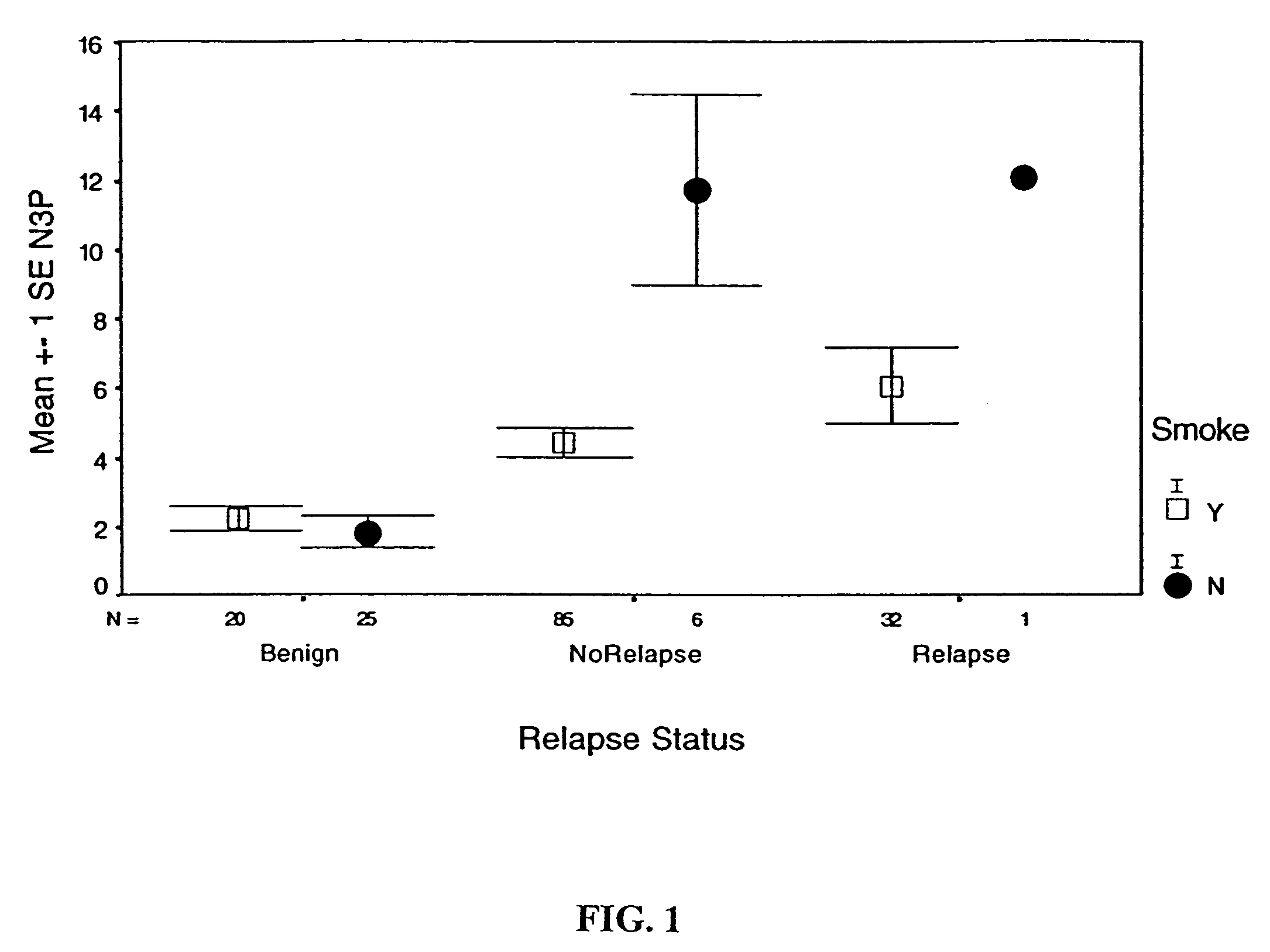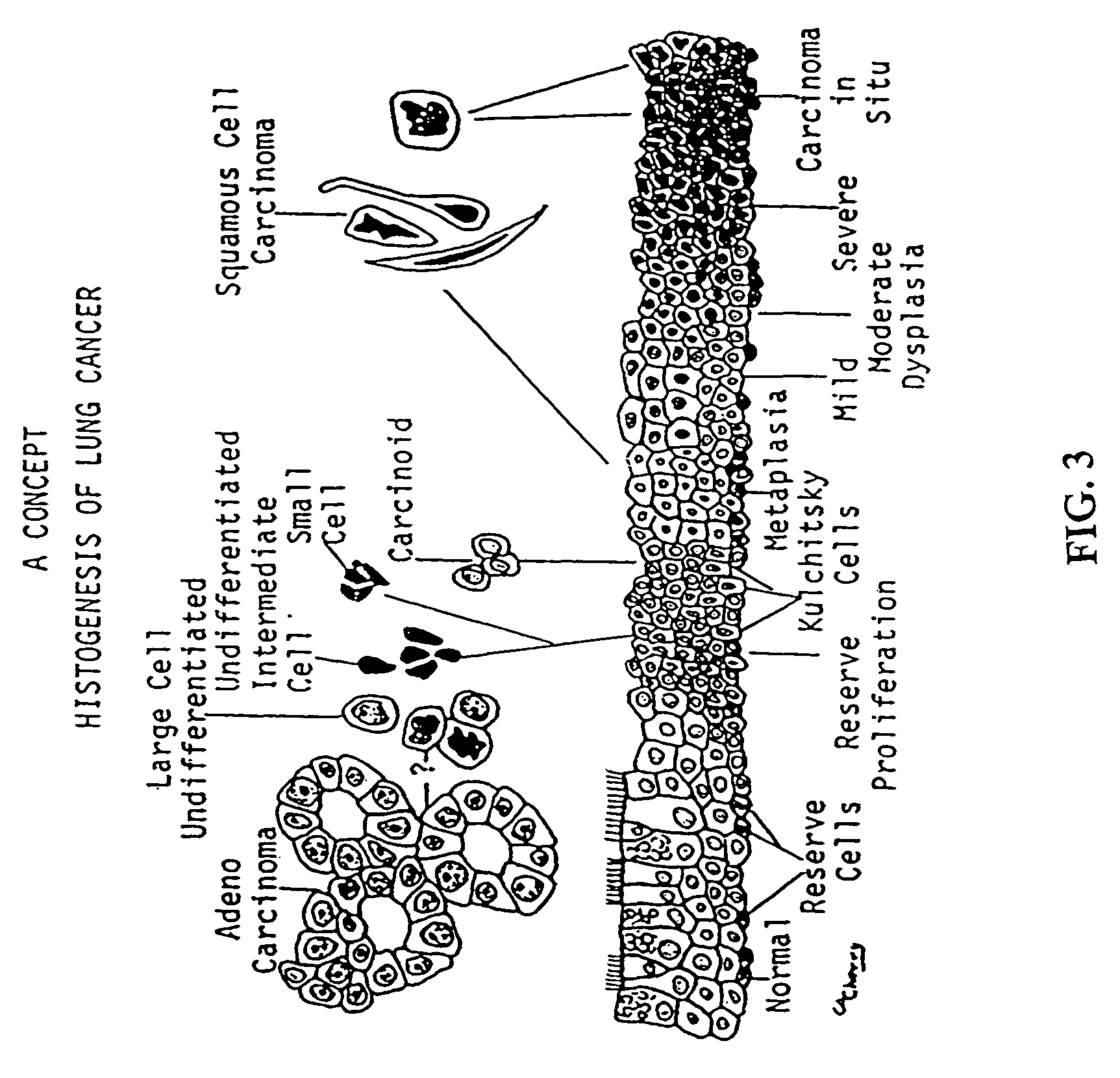Detection and diagnosis of lung or upper airway cancers using 10Q22 as a biomarker
a biomarker and lung cancer technology, applied in the field of oncology, genetics and molecular biology, can solve the problems of increased risk of lung and other smoking-related cancers, and high mortality rate of lung cancer probably
- Summary
- Abstract
- Description
- Claims
- Application Information
AI Technical Summary
Benefits of technology
Problems solved by technology
Method used
Image
Examples
example 1
Lung Cancer Patients and the Correlation Between RPL 14 Gene Deletion Percentage and Patient Survival
[0149]Tissue Samples Normal lung tissue and cancerous lung tissue were obtained from lung biopsies embedded in paraffin blocks. These paraffin embedded histologic tissue are from a clinically and pathologically well characterized group of patients with stage 1 lung cancers that underwent resection at M. D. Anderson Cancer Center (MDACC) and were obtained from MDACC cases on file. These retrospective samples were drawn so that the retrospective samples were as fresh as possible and still have at least 2 years follow-up. Many cases had 14 years of follow up. Demographic information for these patient groups include: age at the time of diagnosis, race, gender, dietary information, initial treatment, screening test with results, date of diagnosis and follow-up with status, other diagnosis information, tobacco history, alcohol history, other diagnoses associated with tobacco or alcohol use...
example 2
Retrospective Study of Lung Cancer Using 3p21.3 gene probe and FISH detection
[0162]From an initial population of 200 patients studied retrospectively with Stage I lung cancer (culled from >13,000 patient files 1987-1988) the inventors identified 100 patients who had relapsed or died within 5 years. Additionally the inventors obtained archival bronchial tissue from 100 patients with lung tissue removed for reasons other than cancer which formed the basis of the control group. A detailed demographic history including smoking status, occupational history and family history of cancer was obtained for each patient.
[0163]The RPL14 Gene Probe (Located on 3p21.3). Specific primer was designed based on the gene sequence with Electronic-PCR software,. The genomic clone of the gene was isolated from the CITB human BAC DNA library pools (Research genetics, Huntsville, Ala.) using PCR technique with this specific gene primer.
[0164]Isolation of Genomic DNA of 3p21,3. Growth of the positive BAC cl...
example 3
Lung Cancer Susceptibility in Former Heavy Smokers
[0173]A subset of bronchial lavages from former heavy smokers who had quit for an average of 6 years with median pack year history of 46 years was studied for lung cancer susceptibility. The study patients have surveillance bronchoscopy followed by blind biopsies of main bronchi from both lungs. Following this, a bronchial wash was performed, and triaged. Even though all these patients had quit smoking (average 6 years previously) most showed significant deletions for the 3p21 or the 10q22 FISH probes in bronchial wash specimens, indicating that in genetically susceptible individuals molecular defects appear to be persistent and are not related to the number of pack years.
PUM
| Property | Measurement | Unit |
|---|---|---|
| temperatures | aaaaa | aaaaa |
| temperatures | aaaaa | aaaaa |
| temperatures | aaaaa | aaaaa |
Abstract
Description
Claims
Application Information
 Login to View More
Login to View More - R&D
- Intellectual Property
- Life Sciences
- Materials
- Tech Scout
- Unparalleled Data Quality
- Higher Quality Content
- 60% Fewer Hallucinations
Browse by: Latest US Patents, China's latest patents, Technical Efficacy Thesaurus, Application Domain, Technology Topic, Popular Technical Reports.
© 2025 PatSnap. All rights reserved.Legal|Privacy policy|Modern Slavery Act Transparency Statement|Sitemap|About US| Contact US: help@patsnap.com



